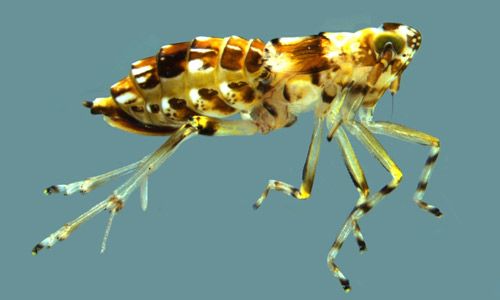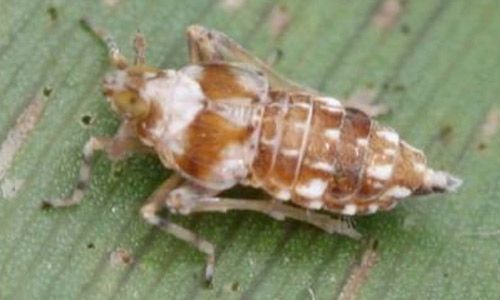The Featured Creatures collection provides in-depth profiles of insects, nematodes, arachnids, and other organisms relevant to Florida. These profiles are intended for the use of interested laypersons with some knowledge of biology as well as academic audiences.
Introduction
The water hyacinth planthopper, Megamelus scutellaris Berg (Figure 1) was introduced as a biological control agent for water hyacinth, Eichhornia crassipes Mart. (Solms) (Pontederiales: Commelinales: Pontederiaceae), in Florida in 2010. The water hyacinth planthopper is the most recently released biological agent on water hyacinth in North America and has been released throughout Florida, Mississippi, Louisiana, and California (Tipping et al. 2014, Moran et al. 2016). Water hyacinth, an invasive aquatic plant, causes extensive damage outside of its native range by blanketing large bodies of water. Dense mats of water hyacinth reduce the amount of sunlight that reaches fully submerged plants, altering the composition of aquatic communities by depleting the oxygen available for phytoplankton (Ultsch 1973).

Credit: Jeremiah R. Foley, USDA-ARS Invasive Plant Research Laboratory
In addition to the deleterious downstream ecological effects water hyacinth has on aquatic communities, water hyacinth also has negative economic effects. These include obstruction of navigation for both recreational and commercial commerce, cost of manual removal and herbicide treatments, and impediment of water flow by clogging irrigation pumps. In a few extreme cases, water hyacinth has also toppled bridges. Therefore, the need to control water hyacinth by reestablishing natural enemies of this plant is vital for long-term, cost-effective control.
Distribution
The water hyacinth planthopper has a limited recorded distribution within South America. However, the geographic range and distribution is thought to be more extensive, mirroring that of its host, water hyacinth (Sosa et al. 2004, Sosa et al. 2007). It has been recorded in the following countries and provinces: Argentina: Buenos Aires, Chaco, Corrientes, Entre Rios, Formosa, and Santa Fe Provinces; Brazil: Rio de Janeiro, Sao Paulo, Paraná, and Río Grande do Sul states; Peru: Iquitos; and Uruguay.
Description
Adult
Two water hyacinth planthopper adult forms exist. Macropters with fully developed wings (Figure 2) and brachtypters (Figure 3) with reduced wings. Macropters are capable of flight and brachtypters are not.

Credit: Phil W. Tipping, USDA-ARS-IPRL

Credit: Phil W. Tipping, USDA-ARS-IPRL
Macropters are brown with mottled bodies and light brown legs with dark brown rings. The abdomen is brown, lighter at sides, with yellowish spots along the sides of the top of the abdomen. Adult males are 2.5 to 2.9 mm in length and adult females are 3.1 to 3.7 mm in length (Sosa et al. 2004).
Adults are similar to the North American native Megamelus davisi VanDuzee, which occurs on spadderdock (Nuphar advena (Aiton) W.T. Aiton) (Nymphaeales: Nymphaeaceae) and is lighter in color with blackish stripes on the abdomen and thorax. The water hyacinth planthopper adults are also similar to the North American native Megamelus paleatus VanDuzee, which occurs on Pontederia cordata L. (Commelinales: Pontederiaceae) (pickerelweed), but Megamelus paleatus are mottled yellowish-brown and are much larger (males ~5 mm, females ~5.5 mm) (Beamer 1955).
Eggs
The eggs are laid within the petioles of water hyacinth and are approximately 1 mm in length, smooth, and oval in shape. Eggs are milky white when laid and turn yellowish as they age. The egg's apex is sharp, and the bottom is rounded (Sosa et al. 2005).
Nymphs
Five stages of nymphs (instars) are present (Figure 4). The first instars are about 1 mm long and are pale yellow with light brown markings with brown legs and red eyes (Sosa et al. 2005).

Credit: Phil W. Tipping, USDA-ARS-IPRL
Second Instar
This stage is slightly larger than first instars. Bodies are still pale yellow, but the brown markings are darker. Legs are pale yellow with pale brown rings (Sosa et al. 2005).
Third Instar
This stage is colored like second instars but is slightly larger and has a distinguishable v-shaped brown marking on the thorax (Sosa et al. 2005).
Fourth and Fifth Instars
The final two immature stages are very similar to the third instars, but they are larger and the brown markings are darker. Fifth instars are approximately 2.4 mm long (Sosa et al. 2005).
Life Cycle and Biology
The water hyacinth planthopper develops from egg through five nymphal instars to adult solely on water hyacinth and produces multiple overlapping generations per year. Following their final molt, adults mate on the petioles near the water's surface or on the ventral sides of leaves (Sosa et al. 2005). Once mated, females oviposit multiple times, laying one to two eggs within the apical sections of the petiole of water hyacinth (Tipping, unpublished data). Following oviposition, the presence of three lateral scars on the petioles of water hyacinth are occasionally present. Depending on temperature, individual first instar nymphs emerge from their embryonic casing, following a seven- to- 13 day incubation period. Development from egg to adult takes 25 days (Sosa et al. 2005). Depending on environmental stimuli (i.e., host abundance, host quality, and water hyacinth planthopper densities), this insect is capable of producing winged (macropterous) individuals or wingless (brachypterous) individuals (Figure 2).
Hosts
In order to determine the host range of the water hyacinth planthopper in the United States, 106 plant species including 12 from the family Pontederiaceae were used during no-choice oviposition and nymph transfer testing (Tipping et al. 2011). The water hyacinth planthopper was able to use Eichhornia paniculata (Spreng.), Solms, and Pontederia cordata as hosts; however survivorship was low relative to the target host. During the nymph transfer experiments, individuals failed to mature on Pontederia cordata and those that did mature on Eichhornia paniculata failed to produce a second generation (Tipping et al. 2011).
Under laboratory conditions, the water hyacinth planthopper causes extensive damage to water hyacinth, eventually leading to the plant's decline (Figure 5). As the insect's density reaches >100 insects per plant in the laboratory, the plant dies. Using sucking mouthparts to penetrate plant tissues and suck up nutrients, the water hyacinth planthopper causes chlorosis of the petiole and leaf. The wounds created during feeding facilitate fungal ingress, further contributing to impact on the plant (Sutton et al. 2016). In field conditions, the impact of water hyacinth planthopper feeding does not mirror those observed under laboratory conditions. The degree to which Megamelus scutellaris negatively affects water hyacinth may have been an artifact of the rearing design. Field densities are much lower than 100 insects per plant and are closer to five or <5 insects per plant (Tipping, unpublished data). The observed differences in densities between field observations and laboratory experiments is attributed to the propensity for the water hyacinth planthopper to disperse and predation and parasitism of the planthoppers. Parasitism of Megamelus scutellaris by a native egg parasitoid, Kalopolynema ema (Schauff and Grissell) (Hymenoptera: Mymaridae) is estimated to be between 0-26% in the field (Minteer et al., 2016).

Credit: Phil W. Tipping, USDA-ARS-IPRL
Selected References
Minteer CR, Tipping PW, Knowles BK, Valmonte RJ, Foley JR, Gettys LA. 2016. Utilization of an introduced weed biological control agent, Megamelus scutellaris (Hemiptera: Delphacidae), by a native parasitoid. Florida Entomologist, 99: 576-577.
Moran PJ, Pitcairn MJ, Villegas B. 2016. First establishment of the planthopper, Megamelus scutellaris Berg, 1883 (Hemiptera: Delphacidae), released for biological control of water hyacinth in California. The Pan-Pacific Entomologist 92: 32–43.
Sosa A, Cordo HA, Sacco J. 2007. Preliminary evaluation of Megamelus scutellaris Berg (Hemiptera: Delphacidae), a candidate for biological control of waterhyacinth. Biological Control 42: 129–138.
Sosa A, De Remes Lenicov AMM, Mariani R. 2004. Redescription of Megamelus scutellaris Berg (Hemiptera: Delphacidae), a candidate for biological control of water hyacinth. Annals of the Entomological Society of America 97: 271–275.
Sosa AJ, De Remes Lenicov AMM, Mariani R. 2005. Life history of Megamelus scutellaris with description of immature stages (Hemiptera: Delphacidae). Annals of the Entomological Society of America 98: 66–72.
Tipping PW, Center TD, Sosa AJ. 2011. Host specificity assessment and potential impact of Megamelus scutellaris (Hemiptera: Delphacidae) on waterhyacinth Eichhornia crassipes (Pontederiales: Pontederiaceae). Biocontrol Science and Technology 21: 75–87.
Tipping PW, Sosa AJ, Pokorny EN, Foley J. 2014. Release and establishment of Megamelus scutellaris (Hemiptera: Delphacidae) on waterhyacinth in Florida. Florida Entomologist 97: 804–806.
Tipping PW, Smith MC, Lake EC, Minteer CR, Goode AB, Foley JR, Gettys LA. 2020. Classical biological control and apparent competition: Evaluating a waterhyacinth invaded community module. Journal of Applied Ecology, 57: 926-935.
Ultsch G. 1973. Effects of water hyacinths (Eichhornia crassipes) on the microenvironment of aquatic communities. Archiv fur Hydrobiologie 72: 460–473.